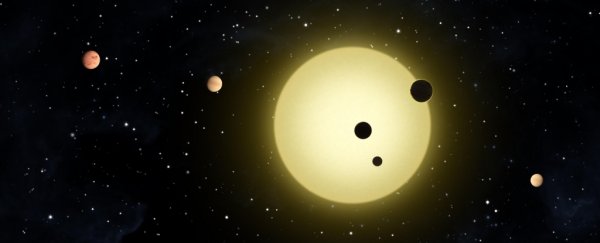You've heard of moonmoons - that's what scientists want to call the satellite of a moon. But are you ready for ploonets? You'd better be, because we're here to tell you about this hypothetical new class of cosmic objects.
It is exactly what it sounds like: a sort-of cross between a moon and a planet. And the existence of ploonets could help explain why we haven't yet conclusively found any exomoons.
A new paper submitted to the Monthly Notices of the Royal Astronomical Society, and still undergoing the peer-review process, lays it all out: Exomoons orbiting giant, Jupiter-sized exoplanets in other planetary systems could be kicked out of orbit via gravitational interactions.
From that point, they could become planetary seeds, or protoplanets. Or… ploonets.
"If large exomoons form around migrating giant planets which are more stable (eg. those in the Solar System), what happens to these moons after migration is still under intense research," the researchers write.
"This paper explores the scenario where large regular exomoons escape after tidal-interchange of angular momentum with its parent planet, becoming small planets by themselves. We name this hypothetical type of object a ploonet."
The team ran simulations of a type of planet known as a hot Jupiter. These are Jupiter-mass gas giants that orbit so close to their host star - around about the same distance as Mercury - that they're incredibly hot.
Astronomers think that these planets would have formed much farther out, and migrated inwards - because the conditions close to the star are so hot, the majority of gas would have burned away, rather than accreting into a planet.
If they had moons while migrating, this movement inwards would generate additional gravitational forces between the moon and the planet.
Mario Sucerquia of the University of Antioquia in Colombia and his colleagues wanted to find out what these forces would do, so they ran a large number of simulations of this migration, where the planet was accompanied by a moon.
They found that around 44 percent of their moons ended up crashing into their planets, and a further 6 percent got eaten up by the star. A very small number - 2 percent - ended up kicked out of the planetary system entirely.
The remaining 48 percent were separated from their planet, but stayed in orbit around the star. These are the ploonets.
Most ploonets - around 54 percent - would end up farther away from the star than their parent planet (outer ploonets), and around 14 percent on an orbit closer to the star (inner ploonets). These may be indistinguishable from a normal planet - so maybe we've already seen some ploonets without even realising.
A whole bunch of them - 28 percent - end up on highly eccentric orbits that cross the planets (crossing ploonets), and the last 4 percent remain on the same or very close orbit as the planet (nearby ploonets). These could interact gravitationally with the planet, betraying their presence by messing with the timing of when the planet passes in front of the star.
The moons that end up destroyed could explain some other things we've seen. Debris kicked up by a collision with a planet, for example, could produce interesting ring systems.
If the moon was an icy one, it could become a swarm of evaporating comets, leaving a long tail in its wake, such as what we've seen orbiting the stars Kepler-1520 and KIC 11026764.
At the end of its life, a ploonet close to the star could experience a number of simultaneous processes, such as surface sublimation and atmospheric evaporation, puffing the atmosphere up so that the planet appears much bigger, and ejecting material into space.
When combined with the lightcurve of the orbit of a planet, this could produce non-periodic and very noisy lightcurves, like those observed around KIC 8462852, which you may know as Tabby's Star or Boyajian's Star. Pretty wild, huh.
Of course, it's all hypothetical at this stage, and the term is not in wide use… yet.
But it's fascinating how little we know about the Universe. We might even have ploonets right here in the Solar System. We might be making one right now.
"Earth's tidal strength is gradually pushing the moon away from us at a rate of about 3 centimetres a year," Sucerquia told New Scientist. "Therefore, the moon is indeed a potential ploonet once it reaches an unstable orbit."
Amazing.
The research has been submitted to the Monthly Notices of the Royal Astronomical Society and is available on arXiv.
